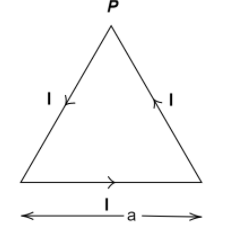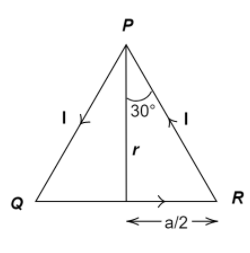
An equilateral triangle of side $a$ carries a current $I$. What is the magnitude and direction of the magnetic field at the point $P$?

Answer
218.7k+ views
Hint: First, we have to know about the magnetic field and how it can be generated from electricity. We can determine the magnetic field's magnitude thus produced if we know about the correlation between the electric field and the magnetic field. After that, we can find out the direction of the generated magnetic field with the right-hand rule.
Formula used:
$B = \dfrac{{{\mu _0}I}}{{2\pi r}}$
Complete step by step solution:
The vector field that describes the magnetic influence on moving electric charges or electric current or any other magnetic material is known as the magnetic field. A current-carrying wire can produce a magnetic field in its surroundings. The right-hand rule can determine the direction of the magnetic field. The correlation of the current and the produced magnetic field can be given as-
$B = \dfrac{{{\mu _0}I}}{{2\pi r}}$
where,
$B$ is the magnitude of the magnetic field
$I$ is the current flowing through the conductor
${\mu _0}$ is the magnetic permittivity of vacuum
$r$ is the distance from the conductor to the point of the magnetic field
However, here, we will think more deeply and use symmetry to solve our problem.
So the sides $PQ$ and $PR$ do not contribute to the generation of the magnetic field at $P$.

Here,
$\Rightarrow r = \sqrt {{a^2} - {{\left( {\dfrac{a}{2}} \right)}^2}} = \sqrt {{a^2} - \dfrac{{{a^2}}}{4}} $
Upon solving further we get,
$\Rightarrow r = \sqrt {\dfrac{{3{a^2}}}{4}} $
$ \Rightarrow r = \dfrac{{\sqrt 3 a}}{2}$
Therefore,
$\Rightarrow B = \dfrac{{{\mu _0}}}{{4\pi }}.\dfrac{I}{r}\left[ {\sin {\alpha _1} + \sin {\alpha _2}} \right]$
We put ${\alpha _1} = {\alpha _2} = {30^ \circ }$ , and we get-
$\Rightarrow B = \dfrac{{{\mu _0}}}{{4\pi }}.\dfrac{I}{{\left( {\dfrac{{\sqrt 3 a}}{2}} \right)}}\left[ {\sin \left( {{{30}^ \circ }} \right) + \sin \left( {{{30}^ \circ }} \right)} \right]$
We put $\sin \left( {{{30}^ \circ }} \right) = \dfrac{1}{2}$-
$\Rightarrow B = \dfrac{{{\mu _0}I}}{{2\sqrt 3 \pi a}}\left[ {\dfrac{1}{2} + \dfrac{1}{2}} \right]$
$ \Rightarrow B = \dfrac{{{\mu _0}I}}{{2\sqrt 3 \pi a}}$
Hence, the magnitude of the generated magnetic field is $\dfrac{{{\mu _0}I}}{{2\sqrt 3 \pi a}}$ , and with the right-hand rule, we can determine that the magnetic field's direction is upward, i.e., pointing outward of the page.
Note: In this problem, we have used the Biot-Savart Law to determine the magnetic field. We will always use the Biot-Savart Law to solve problems where we can use symmetry to find out the magnetic field generated due to the action of a current-carrying conductor.
Formula used:
$B = \dfrac{{{\mu _0}I}}{{2\pi r}}$
Complete step by step solution:
The vector field that describes the magnetic influence on moving electric charges or electric current or any other magnetic material is known as the magnetic field. A current-carrying wire can produce a magnetic field in its surroundings. The right-hand rule can determine the direction of the magnetic field. The correlation of the current and the produced magnetic field can be given as-
$B = \dfrac{{{\mu _0}I}}{{2\pi r}}$
where,
$B$ is the magnitude of the magnetic field
$I$ is the current flowing through the conductor
${\mu _0}$ is the magnetic permittivity of vacuum
$r$ is the distance from the conductor to the point of the magnetic field
However, here, we will think more deeply and use symmetry to solve our problem.
So the sides $PQ$ and $PR$ do not contribute to the generation of the magnetic field at $P$.

Here,
$\Rightarrow r = \sqrt {{a^2} - {{\left( {\dfrac{a}{2}} \right)}^2}} = \sqrt {{a^2} - \dfrac{{{a^2}}}{4}} $
Upon solving further we get,
$\Rightarrow r = \sqrt {\dfrac{{3{a^2}}}{4}} $
$ \Rightarrow r = \dfrac{{\sqrt 3 a}}{2}$
Therefore,
$\Rightarrow B = \dfrac{{{\mu _0}}}{{4\pi }}.\dfrac{I}{r}\left[ {\sin {\alpha _1} + \sin {\alpha _2}} \right]$
We put ${\alpha _1} = {\alpha _2} = {30^ \circ }$ , and we get-
$\Rightarrow B = \dfrac{{{\mu _0}}}{{4\pi }}.\dfrac{I}{{\left( {\dfrac{{\sqrt 3 a}}{2}} \right)}}\left[ {\sin \left( {{{30}^ \circ }} \right) + \sin \left( {{{30}^ \circ }} \right)} \right]$
We put $\sin \left( {{{30}^ \circ }} \right) = \dfrac{1}{2}$-
$\Rightarrow B = \dfrac{{{\mu _0}I}}{{2\sqrt 3 \pi a}}\left[ {\dfrac{1}{2} + \dfrac{1}{2}} \right]$
$ \Rightarrow B = \dfrac{{{\mu _0}I}}{{2\sqrt 3 \pi a}}$
Hence, the magnitude of the generated magnetic field is $\dfrac{{{\mu _0}I}}{{2\sqrt 3 \pi a}}$ , and with the right-hand rule, we can determine that the magnetic field's direction is upward, i.e., pointing outward of the page.
Note: In this problem, we have used the Biot-Savart Law to determine the magnetic field. We will always use the Biot-Savart Law to solve problems where we can use symmetry to find out the magnetic field generated due to the action of a current-carrying conductor.
Recently Updated Pages
A square frame of side 10 cm and a long straight wire class 12 physics JEE_Main

The work done in slowly moving an electron of charge class 12 physics JEE_Main

Two identical charged spheres suspended from a common class 12 physics JEE_Main

According to Bohrs theory the timeaveraged magnetic class 12 physics JEE_Main

ill in the blanks Pure tungsten has A Low resistivity class 12 physics JEE_Main

The value of the resistor RS needed in the DC voltage class 12 physics JEE_Main

Trending doubts
Understanding Collisions: Types and Examples for Students

Understanding Atomic Structure for Beginners

Understanding Centrifugal Force in Physics

Understanding Electromagnetic Waves and Their Importance

Formula for number of images formed by two plane mirrors class 12 physics JEE_Main

JEE Main 2025-26 Mock Test: Ultimate Practice Guide for Aspirants

Other Pages
Diffraction of Light - Young’s Single Slit Experiment

What Are Elastic Collisions in One Dimension?

Understanding Excess Pressure Inside a Liquid Drop

Dual Nature of Radiation and Matter Class 12 Physics Chapter 11 CBSE Notes - 2025-26

Understanding Elastic Collisions in Two Dimensions

Understanding the Wheatstone Bridge: Principles, Formula, and Applications




